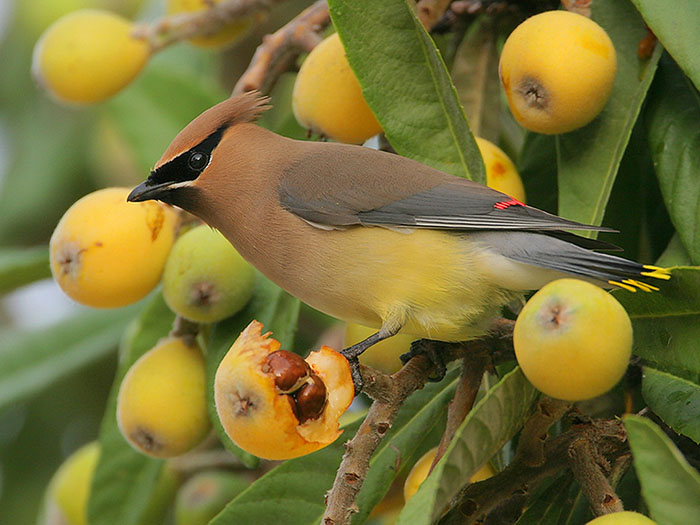The Cedar Waxwing is a sleek, medium-sized bird. They have short necks, short, wide bills, and large heads. These birds have a crest that hangs over the back of the head and lays flat. Cedar Waxwings have square-tipped, relatively short tails.
You’ll often hear a Cedar Waxwing before you see it. We recommend that you learn their high-pitched call so that you can find them more easily.
Cedar Waxwings inhabit many areas like, high in evergreens, over ponds, low in berry bushes, and along rivers. Be sure to look at big flocks of small birds. Cedar Waxwings frequently form large disorderly flocks that divide, grow, rejoin, and shrink.
On this page
Breeding Male
Breeding male Cedar Waxwings are pale brown on the chest and head that fades to a soft gray on the wings. They have gray tails with bright yellow tips and pale yellow bellies.
Cedar Waxwings have narrow black masks that are cleanly outlined with white. They have red waxy tips on their wing feathers, which can be hard to see.
Cedar Waxwings are 5.5 to 6.7 inches (14 to 17 centimeters) long and weigh 1.1 ounces (32 grams). For reference, they are a little bit smaller than Bohemian Waxwings.
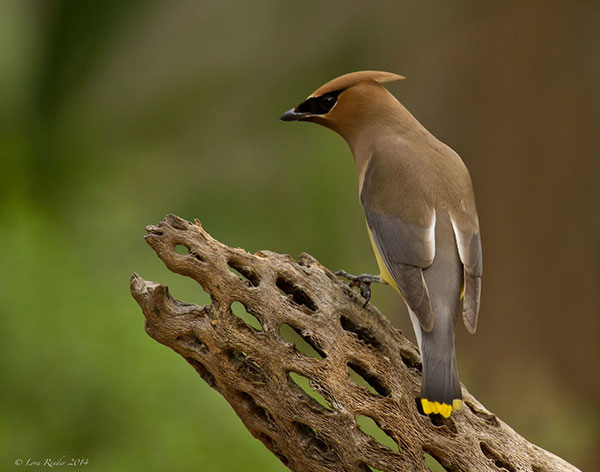
Female
Female Cedar Waxwings look identical to male Cedar Waxwings.
Juvenile
Juvenile Cedar Waxwings have a lot more marking than adults do. The black mask is fainter, and they have dusky streaks below.
It takes around 12 to 13 days for Cedar Waxwings to hatch, leaving the nest between 14 to 18 days after hatching. Both parents will continue to feed their young for a week after they leave the nest.
Habitat
Cedar Waxwings inhabit coniferous, mixed, and deciduous woodlands. They prefer areas of woodlands along streams. You may also find them in grasslands, old fields, desert washes, and sagebrush.
Ornamental berry trees have become an extremely popular choice in landscaping; because of this, Cedar Waxwings are becoming more common in suburbs and towns.
These birds are plentiful in the winter, around fruiting plants in parks, open woodlands, gardens, second-growth forests, and forest edges. Cedar Waxwings that winter in the tropics usually inhabit highlands.
Diet
Cedar Waxwings primarily consume fruit. In the summer months, these birds feed on fruits like strawberries, serviceberry, mulberry, raspberry, and dogwood. The birds’ got their name from their taste for cedar berries in the winter.
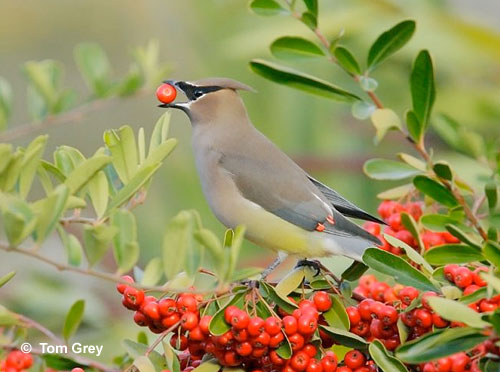
Cedar Waxwing
They’ve also been known to consume madrone, mistletoe, juniper, honeysuckle, mountain ash, crabapple, Russian olive fruits, and hawthorn. Cedar Waxwings supplement their diet in the summer with protein-rich insects like stoneflies, dragonflies, and mayflies.
They’ve also been known to consume scale insects like spruce budworms and leaf beetles directly from vegetation.
Behavior
Cedar Waxwings are extremely social birds that nest in roomy clusters and form large flocks. When feeding, these birds pluck fruit one by one and swallow them whole.
These birds usually feed while perched on a twig, but they’ve also been observed grabbing berries while briefly hovering. Cedar Waxwings make long, zig-zagging flights over water or fly out from an exposed perch when they consume insects.
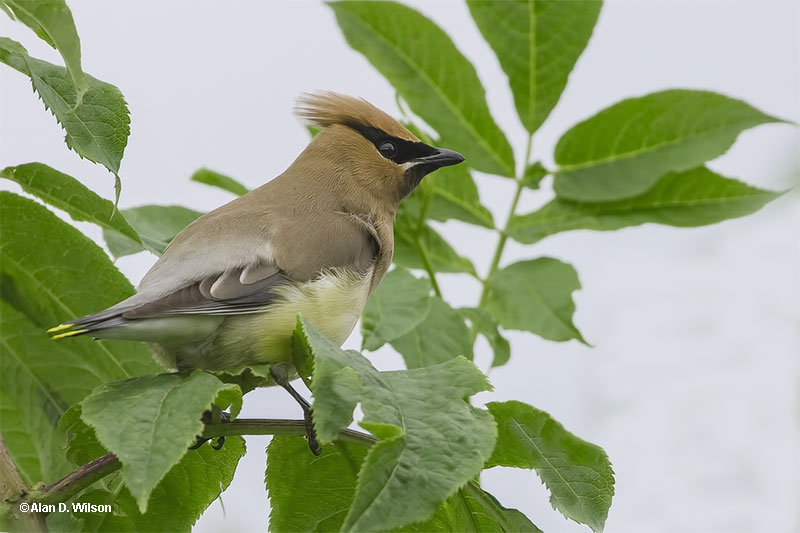
When courting, male and female Cedar Waxwings hop toward each other, alternating back and forth. In this courtship, they’ll sometimes even touch their bills together.
Males usually pass a small object like a flower petal, insect, or fruit to the female. After taking the object, the female will hop away and return to give the object back to the male.
They repeat this process a few times until the female consumes the gift.
Range (and seasonal changes)
Cedar Waxwings are short to long-distance migrants. Many birds in the eastern portions of North America winter in the southeastern United States. However, some travel as far south as Panama and Costa Rica.
Wing shape
Cedar Waxwings have pointed, broad wings and a wingspan of 8.7 to 11.8 inches (22 to 30 centimeters). Their wings are very similar to Starling‘s wings.
Fun Facts
- Cedar Waxwings can fly very fast! They have direct and impressive flight and can fly at a speed of 25 mph.
- Brown-headed Cowbirds lay their eggs in Cedar Waxwing nests. However, the hatchlings usually don’t survive because they can’t grow on such a high-fruit diet.
- A group of Cedar Waxwings is called a “museum” or an “ear-full” of waxwings.
- Because Cedar Waxwings eat so much fruit, they’ll sometimes become intoxicated by fermented berries.
- It takes 5 to 6 days for a female Cedar Waxwing to build her nest. Sometimes she’ll even steal materials from other species’ nests to save time.
Vocalization
Cedar Waxwings have two calls that are pretty common. A sighing whistle and a high-pitched, trilled bzeee. These calls are about a half-second long and usually rise in pitch at the beginning of the call.
These birds are very vocal and call often. This is especially true in flight.
Similar Species
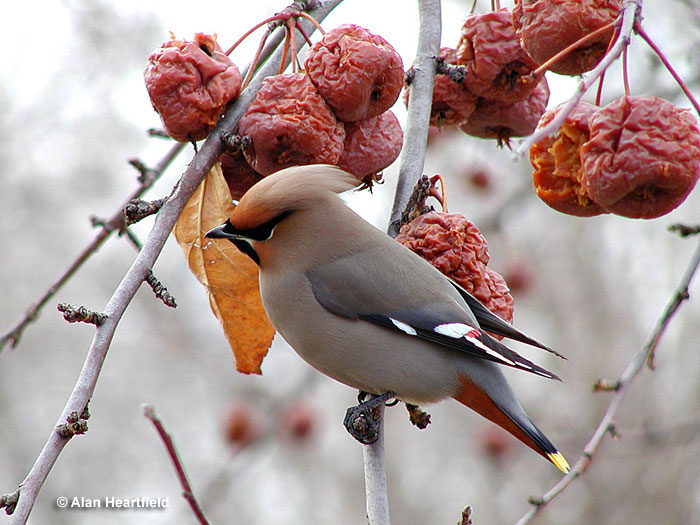
Bohemian Waxwing
Both Cedar Waxwings and Bohemian Waxwings have a unique silky complexion. But that’s where the similarities end.
Bohemian Waxwings are grayish in color, with some brownish colors on their faces. Meanwhile, Cedar Waxwings have more yellow and brownish colors in their plumage.
Bohemian Waxwings tend to be a bit bigger in size too.
Frequently Asked Questions
Where do Cedar Waxwings live?
Cedar Waxwings inhabit coniferous, mixed, and deciduous woodlands. They prefer areas of woodlands along streams. You may also find them in grasslands, old fields, desert washes, and sagebrush.
What does a Cedar Waxwing sound like?
Cedar Waxwings have two calls that are pretty common. A sighing whistle and a high-pitched, trilled bzeee.
Is it rare to see a Cedar Waxwing?
No, Cedar Waxwings are not rare. They have an estimated global breeding population of 64 million. They’re rated 6 out of 20 on the Continental Concern Score which means they’re a species of low concern. The increase in their populations are probably partially due to reversion of fields to forests and shrublands as well as the use of berry trees in landscaping.
Where do Cedar Waxwings go in the winter?
In the winter months, these birds are plentiful around fruiting plants in parks, open woodlands, gardens, second-growth forests, and forest edges. Cedar Waxwings that winter in the tropics usually inhabit highlands.
Do Cedar Waxwings go to bird feeders?
Cedar Waxwings aren’t birds that regularly come to feeders. However, that doesn’t mean you can’t get them to come to your feeders. If you offer the right foods like currants, small apple chunks, cranberries, chopped grapes, and raisins may tempt these birds and utilize tray or large, open platform feeders where flocks can feel comfortable making them more likely to come back.

